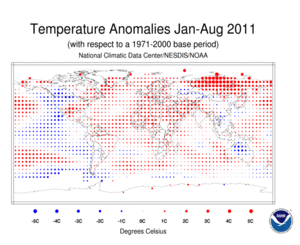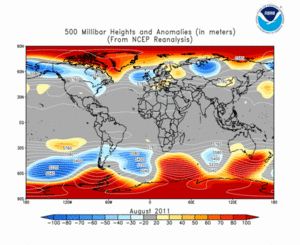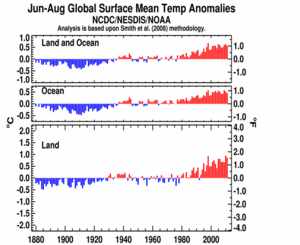Contents of this Section:
 August 2011 Selected Climate
August 2011 Selected Climate
Anomalies and Events Map
Global Highlights
- The combined global land and ocean surface temperature for August 2011 was the eighth warmest on record at 16.15°C (61.09°F), which is 0.55°C (0.99°F) above the 20th century average of 15.6°C (60.1°F).
- The August worldwide land surface temperature was 0.84°C (1.51°F) above the 20th century average of 13.8°C (56.9°F)—the second warmest August on record, behind 1998.
- The worldwide ocean surface temperature was 0.44°C (0.79°F) above the 20th century average of 16.4°C (61.4°F), making this the 12th warmest August on record.
- The combined global land and ocean average surface temperature for June–August 2011 was the seventh warmest on record, at 16.16°C (61.11°F), which is 0.56°C (1.01°F) above the 20th century average of 15.6°C (60.1°F).
- For January–August 2011, the global combined land and ocean surface temperature of 14.51°C (58.22°F) was the 11th warmest January–August period on record. This value is 0.51°C (0.92°F) above the 20th century average.
Please Note: The data presented in this report are preliminary. Ranks and anomalies for August change as more complete data are received and processed. Effective with the July 2009 State of the Climate Report, NCDC transitioned to the new version (version 3b) of the extended reconstructed sea surface temperature (ERSST) dataset. ERSST.v3b is an improved extended SST reconstruction over version 2. For more information about the differences between ERSST.v3b and ERSST.v2 and to access the most current data, please visit NCDC's Global Surface Temperature Anomalies page.
Introduction
Temperature anomalies for August 2011 and June–August 2011 are shown on the dot maps below. The dot maps on the left provide a spatial representation of anomalies calculated from the Global Historical Climatology Network (GHCN) dataset of land surface stations using a 1961–90 base period. The dot maps on the right are a product of a merged land surface and sea surface temperature (SST) anomaly analysis developed by Smith et al. (2008). For the merged land surface and SST analysis, temperature anomalies with respect to the 1971–2000 average for land and ocean are analyzed separately and then merged to form the global analysis. For more information, please visit NCDC's Global Surface Temperature Anomalies page.
August
The average global land surface temperature for August 2011 was the second warmest August, behind 1998, since records began in 1880. The temperature was 0.84°C (1.51°F) above the 20th century average. This is similar to the July 2011 temperature anomaly and continues a streak of 142 consecutive months (since November 2000) that the monthly global land temperature has been above the long-term average. Warmer-than-average conditions occurred across most of North America and the northern half of South America, southern Greenland, eastern Russia, Mongolia, most of Europe, northern Africa to Southwest Asia, and southern Australia. Cooler-than-average regions around the globe included western Russia, the United Kingdom, Alaska, Chile, Argentina, and Uruguay.
The Northern Hemisphere had its was the fourth warmest August land temperature on record, at 0.90°C (1.62°F) above average. Several all-time temperature records were broken in the southern United States and across large parts of eastern and southern Europe as large domes of high pressure settled over those regions. It was the second warmest August on record for the United States, at 1.6°C (3.0°F) above the national average for the month. In southern Europe, Spain reported its sixth warmest August on record since 1961 and fourth warmest since the beginning of the 21st century, with the temperature 1.4°C (2.5°F) above average, according to Spain's meteorological office (Agencia Estatal de Meteorología). However, in Western Europe, Scotland and Northern Ireland had their coolest average monthly August temperatures since 1993, according to the U.K. Met Office. Scotland was 0.7°C (1.4°F) below its 1971–2000 average of 12.9°C (55.2°F) while Northern Ireland was 0.8°C (1.3°F) below its average temperature of 14.2°C (57.6°F).
It was the sixth warmest August land temperature on record for the Southern Hemisphere, at 0.66°C (1.19°F) above average, as well as the warmest monthly temperature anomaly for that hemisphere since May 2010. In Australia, the August 2011 average maximum temperature was the fifth warmest August in the 62-year period of record, according to the country's Bureau of Meteorology. The state of Tasmania had its all-time warmest August maximum and minimum temperatures, at 2.22°C (4.00°F) and 2.63°C (4.74°F above average, respectively.
In the east central equatorial Pacific Ocean, cool La Niña conditions re-emerged during August 2011. According to NOAA's Climate Prediction Center, La Niña is expected to gradually strengthen and continue into the Northern Hemisphere winter 2011/12. The August 2011 global ocean surface temperature was 0.44°C (0.79°F) above average, the 12th warmest such period on record but less warm than the previous month when ENSO-neutral conditions prevailed. The warmth was most pronounced across the north central, northwest, and south central Pacific Ocean, the north central Atlantic, and the Labrador Sea.
Combining global land and ocean temperatures, August 2011 was the eighth warmest August on record, at 0.55°C (0.99°F) above the 20th century average. Similar to the ocean temperature, this month was also slightly cooler with respect to temperature anomalies than the previous month. Nevertheless, August 2011 marked the 318th consecutive month (since February 1985) with the average monthly global land and ocean temperature above the 20th century average.
June–August - Northern Hemisphere Summer, Southern Hemisphere Winter
For the June–August three month period (Northern Hemisphere summer / Southern Hemisphere winter), this was the third warmest global land surface temperature on record. This was also the 19th consecutive June–August with the average global land temperature above the 20th century average. The 2011 Northern Hemisphere summer was the second warmest on record, behind 2010, while the Southern Hemisphere winter was the eighth warmest on record. Across the globe, warmer-than-average conditions were observed across Mexico, the eastern two-thirds of the United States and Canada, and most of Europe and Asia. Cooler-than-average regions included Alaska, Chile, Argentina, Uruguay, part of western Russia, northern Kazakhstan, and northern Australia.
In northern Europe, Finland had its fourth warmest summer since records began in the early 1900s with temperatures 2.62°C (6.52°F) above the 1971–2000 average, according to the Finnish Meteorological Institute.
The June–August 2011 global ocean temperature ranked as the 12th warmest in the 132-year period of record as ENSO-neutral conditions held during June and July before returning to La Niña in August. The warmth was most pronounced across the north central, northwest, and south central Pacific, the equatorial north Atlantic, and the Labrador Sea.
Combined, the June–August global land and ocean temperature was the seventh warmest such period on record and the 35th consecutive June–August (since 1976) with the average temperature above the long-term average. Separately, it was the 26th consecutive above-average Northern Hemisphere summer and 43rd consecutive above-average Southern Hemisphere winter.
Year-to-date (January–August)
The  January–August 2011 map of temperature anomalies shows above-average temperatures over most of the globe's surface area. This year to-date was the seventh warmest such period over global land surfaces on average and 11th warmest for the average ocean surface temperature. The combined average global January–August land and ocean surface temperature was 0.51°C (0.92°F) above the 20th century average, the 11th warmest on record. This also marks the 34th consecutive January–August period with an anomaly warmer than the long-term average. Warmer-than-average conditions were prevalent across Russia, southern Greenland, Mexico, the southern United States, much of Alaska, eastern Canada, the Middle East, nearly all of Africa, and most of Europe. Cooler-than-average temperatures prevailed over northern and central Australia, the north and northwest United States, and southwest Canada. In the oceans, the warmth was most pronounced across the north central, northwest, and south central Pacific, the equatorial Atlantic, and the Labrador Sea.
January–August 2011 map of temperature anomalies shows above-average temperatures over most of the globe's surface area. This year to-date was the seventh warmest such period over global land surfaces on average and 11th warmest for the average ocean surface temperature. The combined average global January–August land and ocean surface temperature was 0.51°C (0.92°F) above the 20th century average, the 11th warmest on record. This also marks the 34th consecutive January–August period with an anomaly warmer than the long-term average. Warmer-than-average conditions were prevalent across Russia, southern Greenland, Mexico, the southern United States, much of Alaska, eastern Canada, the Middle East, nearly all of Africa, and most of Europe. Cooler-than-average temperatures prevailed over northern and central Australia, the north and northwest United States, and southwest Canada. In the oceans, the warmth was most pronounced across the north central, northwest, and south central Pacific, the equatorial Atlantic, and the Labrador Sea.
The average position of the upper-level ridges of high pressure and troughs of low pressure (depicted by positive and negative 500-millibar height anomalies on the  August 2011 map and
August 2011 map and  June–August 2011, respectively) are generally reflected by areas of positive and negative temperature anomalies at the surface, respectively. For other Global products, please see the Climate Monitoring Global Products page.
June–August 2011, respectively) are generally reflected by areas of positive and negative temperature anomalies at the surface, respectively. For other Global products, please see the Climate Monitoring Global Products page.
Images of sea surface temperature conditions are available for all weeks during 2011 from the weekly SST page.
Temperature Rankings and Graphics
Current Month | Seasonal | Year-to-date
| August | Anomaly | Rank (out of 132 years) | Warmest on Record | ||||
|---|---|---|---|---|---|---|---|
| °C | °F | Year | °C | °F | |||
| Global | |||||||
| Land | +0.84 ± 0.18 | +1.51 ± 0.32 | 2nd warmest | 1998 | +0.95 | +1.71 | |
| Ocean | +0.44 ± 0.04 | +0.79 ± 0.07 | 12th warmest | 2009* | +0.57 | +1.03 | |
| Land and Ocean | +0.55 ± 0.09 | +0.99 ± 0.16 | 8th warmest | 1998 | +0.67 | +1.21 | |
| Northern Hemisphere | |||||||
| Land | +0.90 ± 0.17 | +1.62 ± 0.31 | 4th warmest* | 2010 | +1.01 | +1.82 | |
| Ocean | +0.45 ± 0.05 | +0.81 ± 0.09 | 11th warmest | 2005 | +0.65 | +1.17 | |
| Land and Ocean | +0.62 ± 0.13 | +1.12 ± 0.23 | 7th warmest* | 2010* | +0.74 | +1.33 | |
| Southern Hemisphere | |||||||
| Land | +0.66 ± 0.16 | +1.19 ± 0.29 | 6th warmest* | 2009 | +1.29 | +2.32 | |
| Ocean | +0.45 ± 0.04 | +0.81 ± 0.07 | 9th warmest | 1998 | +0.57 | +1.03 | |
| Land and Ocean | +0.48 ± 0.06 | +0.86 ± 0.11 | 8th warmest | 2009 | +0.65 | +1.17 | |
*Signifies a tie
* 1998, 2003, and 2005 tied with 2009 as warmest August Global Ocean temperature on record.
* Northern Hemisphere Land tied with 2003 as 4th warmest on record.
* Northern Hemisphere Land and Ocean tied with 2007 as 7th warmest on record.
* Southern Hemisphere Land tied with 2001 and 2006 as 6th warmest on record.
*
| June–August | Anomaly | Rank (out of 132 years) | Warmest on Record | ||||
|---|---|---|---|---|---|---|---|
| °C | °F | Year | °C | °F | |||
| Global | |||||||
| Land | +0.86 ± 0.16 | +1.55 ± 0.29 | 3rd warmest | 2010 | +0.94 | +1.69 | |
| Ocean | +0.45 ± 0.04 | +0.81 ± 0.07 | 11th warmest | 2009* | +0.58 | +1.04 | |
| Land and Ocean | +0.56 ± 0.09 | +1.01 ± 0.16 | 7th warmest* | 1998 | +0.68 | +1.22 | |
| Northern Hemisphere | |||||||
| Land | +0.97 ± 0.16 | +1.75 ± 0.29 | 2nd warmest | 2010 | +1.10 | +1.98 | |
| Ocean | +0.45 ± 0.04 | +0.81 ± 0.07 | 12th warmest | 2005 | +0.64 | +1.15 | |
| Land and Ocean | +0.65 ± 0.12 | +1.17 ± 0.22 | 5th warmest | 2010 | +0.78 | +1.40 | |
| Southern Hemisphere | |||||||
| Land | +0.57 ± 0.13 | +1.03 ± 0.23 | 8th warmest* | 2005 | +0.92 | +1.66 | |
| Ocean | +0.46 ± 0.04 | +0.83 ± 0.07 | 10th warmest | 1998 | +0.59 | +1.06 | |
| Land and Ocean | +0.48 ± 0.07 | +0.86 ± 0.13 | 9th warmest* | 1998 | +0.64 | +1.15 | |
*Signifies a tie
* 1998 tied with 2009 as warmest August Global Ocean temperature on record.
* Global Land and Ocean tied with 2003 as 7th warmest on record.
* Southern Hemisphere Land tied with 2003 as 8th warmest on record.
* Southern Hemisphere Land and Ocean tied with 2010 as 9th warmest on record.
| January–August | Anomaly | Rank (out of 132 years) | Warmest on Record | ||||
|---|---|---|---|---|---|---|---|
| °C | °F | Year | °C | °F | |||
| Global | |||||||
| Land | +0.78 ± 0.20 | +1.40 ± 0.36 | 7th warmest* | 2007 | +1.06 | +1.91 | |
| Ocean | +0.41 ± 0.04 | +0.74 ± 0.07 | 11th warmest | 1998 | +0.57 | +1.03 | |
| Land and Ocean | +0.51 ± 0.10 | +0.92 ± 0.18 | 11th warmest | 2010* | +0.68 | +1.22 | |
| Northern Hemisphere | |||||||
| Land | +0.91 ± 0.25 | +1.64 ± 0.45 | 7th warmest | 2007 | +1.23 | +2.21 | |
| Ocean | +0.39 ± 0.05 | +0.70 ± 0.09 | 11th warmest* | 2010 | +0.57 | +1.03 | |
| Land and Ocean | +0.59 ± 0.15 | +1.06 ± 0.27 | 9th warmest* | 2010 | +0.78 | +1.40 | |
| Southern Hemisphere | |||||||
| Land | +0.44 ± 0.15 | +0.79 ± 0.27 | 19th warmest* | 2005 | +0.91 | +1.64 | |
| Ocean | +0.44 ± 0.04 | +0.79 ± 0.07 | 10th warmest | 1998 | +0.60 | +1.08 | |
| Land and Ocean | +0.44 ± 0.07 | +0.79 ± 0.13 | 11th warmest | 1998 | +0.65 | +1.17 | |
*Signifies a tie
* Global Land tied with 2006 as 7th warmest on record.
* 1998 tied with 2010 as warmest August Global Land and Ocean temperature on record.
* Northern Hemisphere Ocean tied with 1997 as 11th warmest on record.
* Northern Hemisphere Land and Ocean tied with 2003 as 9th warmest on record.
* Southern Hemisphere Land tied with 1986 and 1993 as 19th warmest on record.
The most current data August be accessed via the Global Surface Temperature Anomalies page.
Precipitation
The maps below represent anomaly values based on the GHCN dataset of land surface stations using a base period of 1961–90. During August 2011, above-average precipitation fell over areas that included Southwestern Asia where the monsoon season was in full swing, the northeast United States, where Hurricane Irene brought torrential rainfall, and several locations across northern Africa. The areas with the driest anomalies during August 2011 were observed across the southern tier of the United States where record breaking drought was occurring, along with the western United States, much of South America, and most of Australia.
During the June–August 2011 period, above-average precipitation fell over areas that included the Dominican Republic, which had received rainfall from tropical storms Emily and Irene, South Africa, northwest Africa, and the northeastern United States. The driest anomalies during June–August 2011 were observed across eastern Brazil, Argentina, northeastern Bolivia, the southern United States, Mongolia, and northern Australia.
Additional details on flooding and drought events around the world can also be found on the August 2011 Global Hazards page.
References
Christy, John R., R.W. Spencer, and W.D. Braswell, 2000: MSU tropospheric Temperatures: Dataset Construction and Radiosonde Comparisons. J. of Atmos. and Oceanic Technology, 17, 1153-1170.
Free, M., D.J. Seidel, J.K. Angell, J. Lanzante, I. Durre and T.C. Peterson (2005) Radiosonde Atmospheric Temperature Products for Assessing Climate (RATPAC): A new dataset of large-area anomaly time series, J. Geophys. Res., 10.1029/2005JD006169.
Free, M., J.K. Angell, I. Durre, J. Lanzante, T.C. Peterson and D.J. Seidel(2004), Using first differences to reduce inhomogeneity in radiosonde temperature datasets, J. Climate, 21, 4171-4179.
Fu, Q., C.M. Johanson, S.G. Warren, and D.J. Seidel, 2004: Contribution of stratospheric cooling to satellite-inferred tropospheric temperature trends. Nature, 429, 55-58.
Lanzante, J.R., S.A. Klein, and D.J. Seidel (2003a), Temporal homogenization of monthly radiosonde temperature data. Part I: Methodology, J. Climate, 16, 224-240.
Lanzante, J.R., S.A. Klein, and D.J. Seidel (2003b), Temporal homogenization of monthly radiosonde temperature data. Part II: trends, sensitivities, and MSU comparison, J. Climate, 16, 241 262.
Mears, Carl A., M.C. Schabel, F.J. Wentz, 2003: A Reanalysis of the MSU Channel 2 tropospheric Temperature Record. J. Clim, 16, 3650-3664.
Peterson, T.C. and R.S. Vose, 1997: An Overview of the Global Historical Climatology Network Database. Bull. Amer. Meteorol. Soc., 78, 2837-2849.
Quayle, R.G., T.C. Peterson, A.N. Basist, and C. S. Godfrey, 1999: An operational near-real-time global temperature index. Geophys. Res. Lett., 26, 333-335.
Smith, T.M., and R.W. Reynolds (2005), A global merged land air and sea surface temperature reconstruction based on historical observations (1880-1997), J. Clim., 18, 2021-2036.
Smith, et al (2008), Improvements to NOAA's Historical Merged Land-Ocean Surface Temperature Analysis (1880-2006), J. Climate., 21, 2283-2293.
 NOAA's National Centers for Environmental Information
NOAA's National Centers for Environmental Information











